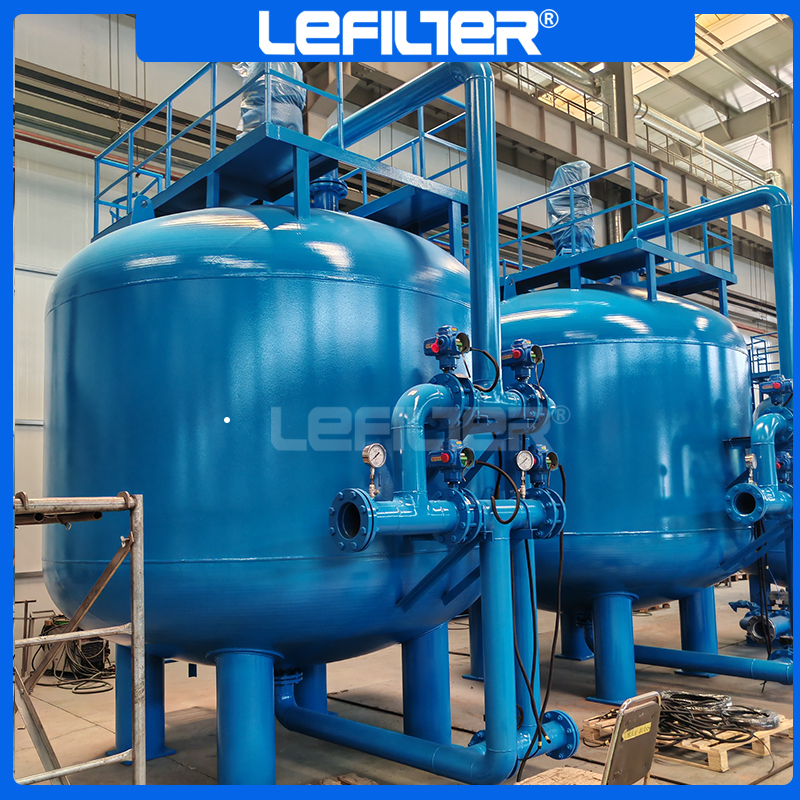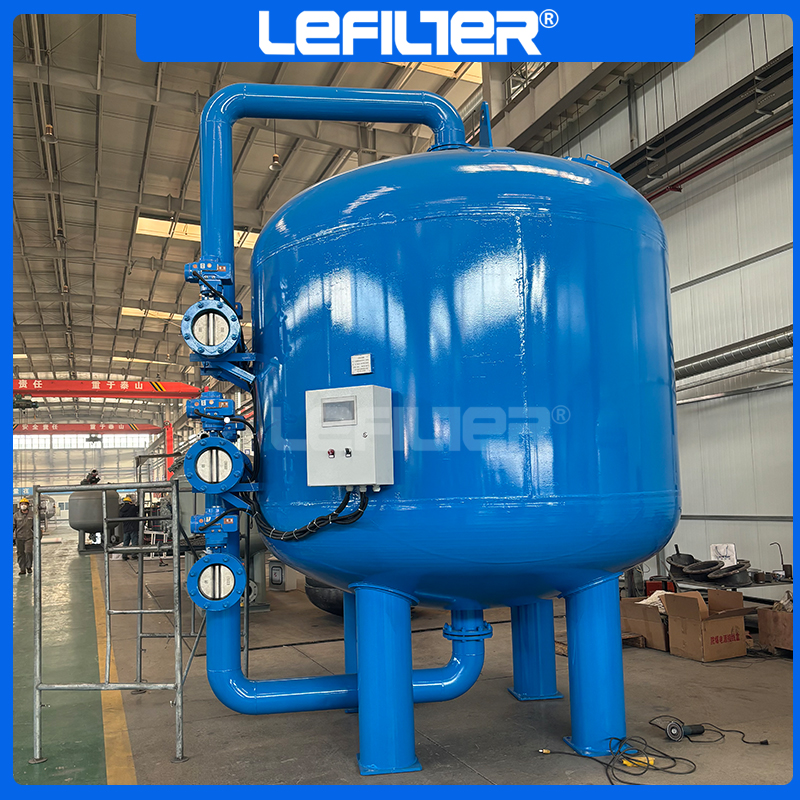The Role of Multimedia Filtration in RO Pretreatment
DATE:2024-09-27 Number of views: 1 Source:dongwenhui
Multimedia filtration plays a crucial role in preparing feedwater for reverse osmosis (RO) systems, which are widely used in various applications, including desalination, water purification, and wastewater treatment. By effectively removing suspended solids and other contaminants from the water before it reaches the RO membranes, multimedia filters ensure optimal performance and longevity of the entire system. We explore the importance of multimedia filtration in RO pretreatment and its impact on membrane protection and overall system reliability.
Understanding Reverse Osmosis (RO) Systems
Reverse osmosis is a process that uses a semipermeable membrane to remove ions, molecules, and larger particles from water. In this process, water is forced through the membrane under pressure, allowing only water molecules to pass while rejecting contaminants. While RO systems are highly effective at purifying water, they are also sensitive to the quality of the feedwater. Contaminants such as suspended solids, colloids, and organic matter can lead to membrane fouling, scaling, and ultimately reduced system efficiency.
The Necessity of Multimedia Filtration
Multimedia filtration is essential for RO systems due to its ability to effectively reduce the concentration of contaminants that can adversely affect membrane performance. Key reasons for its necessity include:
Protection of RO Membranes: Multimedia filters act as a first line of defense, removing larger particles and organic matter that could cause fouling or damage to the delicate RO membranes. By minimizing the introduction of these contaminants, multimedia filters help maintain membrane integrity and function.
Improving Feedwater Quality: The quality of feedwater significantly influences the performance of RO systems. Multimedia filtration enhances the overall quality of the feedwater by reducing turbidity, suspended solids, and other contaminants, ensuring that the RO membranes operate under optimal conditions.

How Multimedia Filtration Protects RO Membranes
The protection of RO membranes is critical for ensuring long-term reliability and efficiency. Multimedia filters contribute to this protection through several mechanisms:
Physical Removal of Particles: The layered structure of multimedia filters allows for the efficient removal of larger particles and suspended solids through straining and sedimentation. This physical barrier prevents these contaminants from reaching the RO membranes, thereby reducing the risk of fouling.
Adsorption of Organics: Certain multimedia filter media, such as activated carbon, are effective at adsorbing organic compounds that can otherwise lead to biofouling. By removing these substances, multimedia filters help maintain a clean membrane surface and enhance overall system performance.
Reduction of Scaling Potential: By removing hardness ions and other scaling precursors, multimedia filters help minimize the potential for scale formation on the RO membranes. This is critical in maintaining membrane permeability and performance over time.
Typical SDI and Turbidity Targets
Before water enters an RO system, it is essential to meet specific quality standards to ensure optimal performance. Two key parameters are the Silt Density Index (SDI) and turbidity:
Silt Density Index (SDI): The SDI measures the potential for membrane fouling caused by suspended solids. A typical SDI target for feedwater entering an RO system is usually less than 3. Higher values indicate a greater likelihood of fouling and may necessitate additional pretreatment steps.
Turbidity: Turbidity is a measure of the cloudiness or haziness of water caused by suspended particles. For RO systems, the turbidity of feedwater should typically be less than 1 NTU (Nephelometric Turbidity Units) to prevent fouling and ensure efficient operation.

Longevity of RO Systems
By effectively removing contaminants, multimedia filtration significantly improves the longevity of RO systems. The benefits include:
Reduced Membrane Replacement Costs: Maintaining clean RO membranes reduces the frequency of membrane replacements, which can be a significant expense in the operation of an RO system.
Lower Maintenance Requirements: With fewer fouling issues, the overall maintenance demands on the RO system are reduced. Operators can expect less downtime and lower operational costs associated with cleaning and maintaining the membranes.
Improved System Reliability: A well-maintained RO system with protected membranes is more reliable and capable of consistently producing high-quality water, meeting the needs of various applications.
Reducing the Need for Chemical Pre-Treatment
One of the significant advantages of incorporating multimedia filters in RO pretreatment is the potential reduction in the need for chemical pre-treatment processes. Chemical treatments, such as the use of coagulants and flocculants, can add complexity and cost to water treatment operations. By effectively removing suspended solids and organic matter, multimedia filters can minimize the reliance on these chemicals, leading to:
Cost Savings: Reducing chemical usage decreases operating costs and simplifies the overall treatment process.
Lower Environmental Impact: Fewer chemicals in the treatment process mean less potential for chemical discharge into the environment, leading to more sustainable water management practices.
Common Problems in RO Pretreatment
Despite their effectiveness, several common issues can arise in RO pretreatment processes involving multimedia filtration:
Fouling of Multimedia Filters: Over time, multimedia filters can become fouled with accumulated solids and organic matter, requiring regular maintenance and cleaning to ensure continued effectiveness.
Inadequate Backwashing: Insufficient backwashing can lead to media compaction and reduced filtration efficiency. Operators must ensure that backwash cycles are performed adequately to maintain optimal filter performance.
Media Degradation: The filter media may degrade over time due to chemical reactions or mechanical stress, necessitating periodic media replacement to ensure consistent performance.
Impact on Desalination Efficiency
In desalination applications, the role of multimedia filtration becomes even more critical. Effective pretreatment directly influences the efficiency of the desalination process:
Increased Recovery Rates: By protecting RO membranes and minimizing fouling, multimedia filtration can increase the recovery rates of desalination systems, leading to more efficient water production.
Enhanced Salt Rejection: A cleaner feedwater stream allows for improved salt rejection rates in RO membranes, resulting in higher quality desalinated water.
Optimized Energy Consumption: Reduced fouling and improved membrane performance translate into lower energy requirements for operating the RO system, contributing to more sustainable desalination practices.

Footprint of Multimedia Filters in RO Plants
The physical footprint of multimedia filters in RO plants can vary based on the design and scale of the treatment system. Typically, multimedia filters require a modest amount of space compared to the overall RO system. Their compact design allows them to be integrated into existing treatment facilities without significant spatial constraints, making them an attractive option for enhancing RO pretreatment.
Industry Solutions
Pure Water /Ultra Pure Water System


